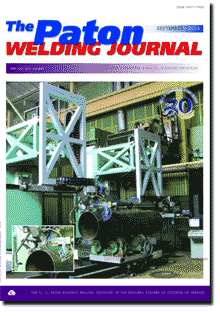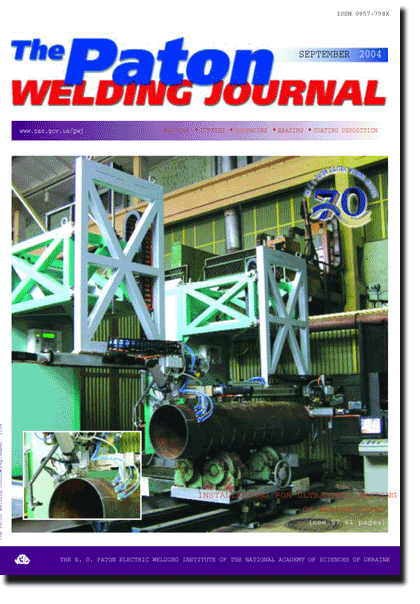

(You are viewing the simplified file contents)
AS = «Automatic Welding» - 6 issues per year;
TPWJ = «PATON WELDING JOURNAL» - 12 issues per year;
SEM = «Electrometallurgy Today» - 4 issues per year;
TDNK = «Technical Diagnostics and Non-Destructive Testing» - 4 issues per year.


| 70 years at advanced positions of technical progress | 2 |
| SCIENTIFIC AND TECHNICAL | |
| Paton B.E. Electric welding of soft tissues in surgery | 6 |
| Main drawbacks of the available methods for joining soft tissues in surgical operations are noted. It has been established that under certain conditions it is possible to join incisions in different organs and soft tissues by the method based on heating the joint zone by high-frequency current. This method has much in common with the resistance welding method, that is why it is called welding. Multiple experiments made on animals, and later in clinics, confirmed that the application of welding in surgery is feasible and highly promising. More than 2,000 patients were operated in the clinics of Kiev. Surgical operations are mentioned, which are characterized by the efficient application of welding, and which were verified and mastered by the Kiev clinics. | |
| Zamkov V.N. and Prilutsky V.P. Theory and practice of TIG-F (A-TIG) welding (Review) | 11 |
| Results of investigation of the effect of fluxes on the process of argon-arc tungsten-electrode welding are considered. Special attention is given to analysis of factors that cause increase in operational characteristics of the arc and, in particular, increase in the penetration depth. It is assumed that increase in the penetration depth is caused by growth of the Lorentz force due to contraction of the arc by flux and increase in current density in the anode region. The effect exerted by changes in the gradient of surface tension of molten metal in the weld pool on penetration is of a secondary importance. | |
| Ishchenko A.Ya. Specifics in application of aluminium high-strength alloys for welded structures | 15 |
| Grades and general characteristic of weldability of new high-strength aluminium alloys, physical-metallurgical processes occurring in their welding, causes of porosity formation and measures for its prevention in weld metal during fusion welding, peculiarities of solidification of welds in multicomponent alloys, as well as formation of hot cracks and measures for their prevention, chemical and structural inhomogeneity are considered. Structural transformations leading to weakening of metal in the HAZ are analysed. Characteristics of new and improved methods and technologies for welding using the electric arc, electron beam and laser heat sources are presented. | |
| Khorunov V.F., Maksimova S.V. and Ivanchenko V.G. Development of filler metals for brazing heat-resistant nickel- and titanium-base alloys | 26 |
| Fundamental studies of alloys of the Ni-Cr-Zr and Ti-Zr-Mn systems have been conducted to investigate the content of elements showing promise in terms of development of brazing filler metals. The data on melting points of the alloys, their phase composition and morphological peculiarities have been obtained. Brazing filler metals have been developed on the basis of the investigation results for brazing high heat-resistant nickel alloys and intermetallic alloy g-TiAl. Structure and properties of brazed joints have been studied. | |
| Kuchuk-Yatsenko S.I., Velikoivanenko E.A.,Rozynka G.F., Shvets Yu.V. and Didkovsky A.V. Investigation of residual stresses in welded joints of rails produced by flash-butt welding | 32 |
| Calculation-experimental method of determination of residual stresses in the zone of welded joints was used. The basic data were obtained by mathematical modeling of the process of formation of elastic-plastic deformations during cooling of the welded parts up to the plastic condition. | |
| Lobanov L.M., Korotynsky A.E., Yumatova V.I. and Skopyuk M.I. Selection of methods for comprehensive assessment of welding equipment quality | 36 |
| Models for determination of quality characteristics of welded equipment are considered. Assessment calculation of weighted average characteristics of quality of welding transformers, which are manufactured by a common technological scheme under the conditions of batch production, is given. | |
| INDUSTRIAL | |
| Yushchenko K.A. Weldability and advanced processes for materials welding | 39 |
| Available methods for materials joining, allowing for an aggregate state of a material within the joining zone, are analysed. The need to revise the term ?weldability? and develop a generalised quantitative criterion for evaluation of weldability is noted. Necessary premises for development of advanced welding processes, including the hybrid ones, are considered. | |
| Dobrushin L.D. State-of-the-art and prospects for development of welding by explosion and high-velocity impact (Review) | 45 |
| State-of-the-art of commercial technologies of welding by explosion (using explosives as the energy source) and high-velocity impact (using pneumatic and powder channel devices, as well as high-velocity water jets as energy sources) is analyzed. Separate consideration is given to attempts to develop a hand tool for local (spot) high-velocity impact welding. Possible trends in development and upgrading of the technologies of welding by explosion and high-velocity impact are considered. | |
| Mikitin Ya.I., Okul V.I., Dukh S.V. and Ilyushenko V.M. Equipment of KZESO Company for arc and electroslag welding | 52 |
| Advanced equipment for arc and electroslag welding and its technological capabilities are considered. Information about technical parameters of serially-manufactured equipment and welding-technological properties of power supply sources is given. | |
| Najda V.L., Mozzhukhin A.A. and Lobanov O.F. New generation of equipment for automated ultrasonic testing of welded pipes | 57 |
| Installations of the new generation for automatic ultrasonic testing, designed using sophisticated elements of mechanics and electronics, are presented. Using this equipment, the testing of welds and end areas of pipes of diameter from 508 to 1420 mm and thickness from 7 to 50 mm can be realized. | |
| Krasilnikov S.G., Gulida V.P., Yushchenko K.A. and Lychko I.I. Cooperation between NKMZ and PWI in the field of electroslag welding for heavy engineering applications | 62 |
| Results of many years of cooperation between NKMZ and PWI in the field of production of large billets using electroslag welding are presented. Examples of successful application of ESW for the fabrication of critical pieces of equipment and specific components are given. Potentialities and prospects of further improvement of the ESW technologies applied in heavy engineering are shown. | |
(You are viewing the simplified file contents)
The cost of subscription/purchase order journals or individual articles
| Journal/Currency | Annual Set | 1 issue printed |
1 issue |
one article |
| AS/UAH | 1800 UAH | 300 UAH | 300 UAH | 150 UAH |
| AS/USD | 192 $ | 32 $ | 26 $ | 16 $ |
| AS/EUR | 180 € | 30 € | 25 € | 15 € |
| TPWJ/UAH | 7200 UAH | 600 UAH | 600 UAH | 280 UAH |
| TPWJ/USD | 384 $ | 32 $ | 26 $ | 16 $ |
| TPWJ/EUR | 360 € | 30 € | 25 € | 15 € |
| SEM/UAH | 1200 UAH | 300 UAH | 300 UAH | 150 UAH |
| SEM/USD | 128 $ | 32 $ | 26 $ | 16 $ |
| SEM/EUR | 120 € | 30 € | 25 € | 15 € |
| TDNK/UAH | 1200 UAH | 300 UAH | 300 UAH | 150 UAH |
| TDNK/USD | 128 $ | 32 $ | 26 $ | 16 $ |
| TDNK/EUR | 120 € | 30 € | 25 € | 15 € |
AS = «Automatic Welding» - 6 issues per year;
TPWJ = «PATON WELDING JOURNAL» - 12 issues per year;
SEM = «Electrometallurgy Today» - 4 issues per year;
TDNK = «Technical Diagnostics and Non-Destructive Testing» - 4 issues per year.

